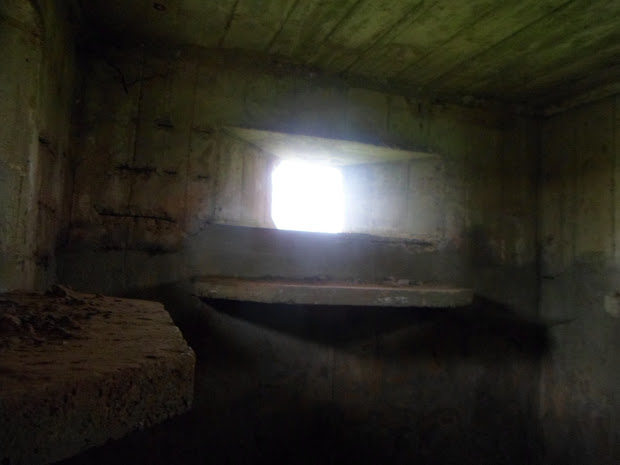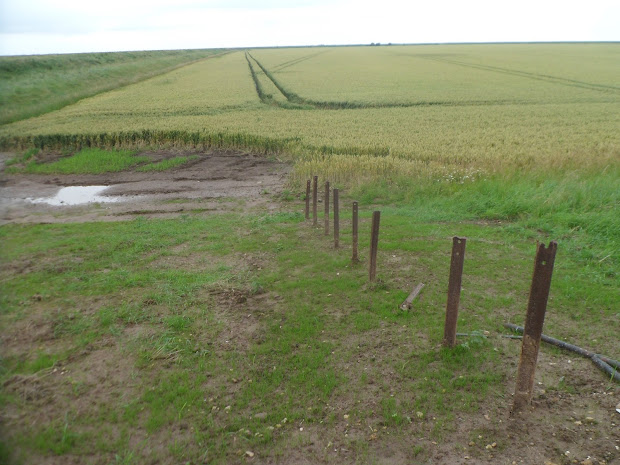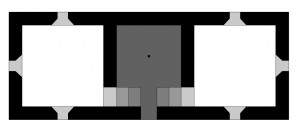Maps of air-historical Lincolnshire

RAF Holbeach is known as the Wash Bombing Range and is located around 8 miles North-North-East of Holbeach village, approximately equidistant from Boston and King's Lynn. The range is intended for air weapons training, principally for RAF and other NATO nations to drop practice bombs and fire cannon.
The boundaries of the range danger zone cover an area of 42 square kilometres between the low water mark and sea bank, from Wainfleet Sands to the north-east to Friskney Flats in the south-west.
Holbeach opened in 1928 as a bombing and gunnery range. There was also a small landing ground at one point.
Lincolnshire 3 Bay
Lincolnshire Three Bay
The Lincolnshire three bay pillbox is a variant form of the FW3/23. Essentially it is two of that type placed back to back and sharing an AAMG well to create a rectangular pillbox approximately 6.5m long and 2.5m wide with three fighting compartments. The two enclosed chambers each have three embrasures, one in each external wall. The AA well has the entrance to the pillbox which faces inland. This type of pillbox was generally used as part of the coastal crust and is found on the seawalls of Lincolnshire. In many cases they are now some distance inland as more farmland has been reclaimed from the sea. So remote and stunning, with the heat of the day and the sound of the occasional bird to keep me company, this was a difficult days walking due to the never ending expanse and long distances i had to cover.


Having spent the first day out with a certain couple of fellow concrete nutters which covered the North side of the Wash, i made the decision to stay out there and visit this line of defences which ran on the south side of the wash. This eventually started at the marsh banks off Middle Marsh road. None of this was an easy visit as it involved foot slogs as the only means to getting to the pillboxes. Firstly though i picked up the two sets of pillboxes on The Scalp. Along this line of bank the pillboxes have been lost or buried under the banks and again to get to these pillboxes it was done the hard way. Taking plenty of water with me and food to ensure i kept my energy levels up, it was a case of bite the bullet and just get to them. Plenty of annoying flies buzzing around to fray my temper.
PILLBOX (TYPE FW3/26): S0005191
One sat on the north side of the marsh bank and facing the Whitam and the sister pillbox a good 30 yards and facing out towards the Wash and the reclaimed marshland.
A type 26 is normally 3 meters square, has a central loop in three of the walls and a doorway and loop in the remaining wall. There are variations according to the build needs of any specific area. Note the two 26 boxes here only have the three embrasures. The walls on a 26 are 18" thick. The examples below were build using wooden plank shuttering which can be seen leaving a 'print' on the concrete. This is more evident on the internal shots taken.







It's sister on the opposing side of the bank. Even with these two pillboxes there are variations in the build. Noticeable in the height of the ceiling from the top of the entrance and the way the shuttering way laid out to pour the concrete and ballast mix.






PILLBOX: S000519
In very close proximity to each other another set of Type 26 pillboxes further up the bank of the wash. Very isolated and exposed.







The long walk back to the car through the nature reserve.

Travelling further down on the A17 and parking up near Middle Marsh Farm, thankfully the rain held of for the most part and i was able to almost get to the end of the run of defences before the light closed in and the sky looked ominous enough to turn back. As mentioned earlier, the pillboxes originally sat close to the wash before the marshland was later drained and reciaimed for farmland. The pllboxes, sat hight up on the original tidal banks now look remote and isolated.
PILLBOX (LINCOLNSHIRE 3 BAY): S0005197







PILLBOX (LINCOLNSHIRE 3 BAY)
In a poor state.




Smashed shelves and exposed reinforced rebars exposed.


The entrance to the pillbox and the LAA pit. The LAA mount in this instance is missing and occasionally found laying on its side in the pit.

PILLBOX (TYPE FW3/26): S0005199
This location puzzles me. I really think it might be an OP.








PILLBOX: S0005200 (infantry blockhouse)
Set very low, what looks like an exit point for what could have been a fireplace (see later pictures), and in a sad state. I still manages to crawl in despite the best efforts of the landowner to prevent this.







#




RUCK MACHINE GUN POST: S0016172
Just enough of a reason to get out there.The Ruck machine gun post (or Ruck pillbox) was designed by James Ruck and was made from prefabricated sections, paving slabs, sandbags and rammed earth. The Ruck machine gun post was relatively widely used in Lincolnshire and along the east coast of England, but is now extremely rare with just a handful of extant examples. Five Ruck machine gun post sites are recorded in the Defence of Britain database, only two of which are thought to be extant.
Constructed from Stanton air raid shelter sections and was covered in additional concrete slabs. The segments were made at the Stanton Ironworks Ilkeston Derbyshire in the Concrete Plant which converted from production of concrete lighting columns during the war. “The segments were 20 inches (50 cm) wide and 2 inches (5 cm) thick, a pair of them formed an arch 7 feet [2.1 m] high and transverse struts were provided to ensure rigidity. These fitted into longitudinal bearers, which were grooved to receive the foot of each segment. Each pair of segments were bolted together at the apex of the arch and each segment was also bolted to it neighbour, the joints being sealed with bituminous compound.” The convenient handling of these segments enabled them to be transported with ease. Partly buried in the ground and covered with turf and sandbags, with a suitably screened entrance, this bolted arch construction afforded safe protection against blast and splinters.











A pillbox buried and sat right next to the Ruck Post. South side.



PILLBOX (LINCOLNSHIRE 3 BAY): S0005203




Reference point for the Infantry block house which needs listing as this is classed as a Lincolnshire Three bay.

Thankfully all the breeze blocks have been removed and it is back to original spec. The Breeze blocks had been placed onto the roof and it was used as a temporary shooting platform. Show some respect!!
S0005202










Back onto the perimeter track and the long walk back to the car.

Thanks for viewing.

No comments:
Post a Comment